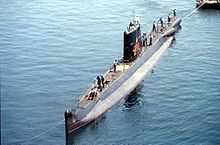SAS Umkhonto
 c1994 | |
| Career (South Africa) | |
|---|---|
| Name: | SAS Emily Hobhouse (until 1994, when renamed SAS Umkhonto) |
| Namesake: | Emily Hobhouse was a British humanitarian in South Africa during the Boer War. Umkhonto is the Zulu word for "spear" |
| Owner: | South African Navy |
| Operator: | South African Navy |
| Builder: | Dubigeon-Normandie |
| Launched: | 19 June 1962 |
| Commissioned: | 26 February 1971 |
| Out of service: | 2003 |
| Homeport: | Simon's Town |
| Identification: | S 98 |
| Fate: | Decommissioned in 2003 and scrapped in 2008 |
| General characteristics | |
| Class and type: | Daphné class |
| Displacement: | 869 tonnes surfaced 1,043 tonnes submerged |
| Length: | 57.75 metres |
| Beam: | 6.74 metres |
| Draught: | 5.25 metres |
| Propulsion: | Diesel-electric, two shafts, 1,600 shp |
| Speed: | Submerged: 16 knots (30 km/h) Schnorcheling: 8 knots (15 km/h) Surfaced: 12 knots (22.2 km/h) |
| Range: | Surfaced: 10,000 nautical miles (20,000 km) at 7 knots (13 km/h) |
| Endurance: | 30 days |
| Test depth: | 300 metres |
The SAS Umkhonto (S98), formerly the SAS Emily Hobhouse, was the second of three French-built Daphné class submarines ordered by the South African Navy in 1968. Laid down in December 1968 and launched 24 October 1969 and commissioned into the South African Navy under the command of Lt Cdr Lambert Jackson "Woody" Woodburne on 26 February 1971.[1] The submarine was decommissioned in 2003 and scrapped in 2008.
Ship Name
The SAS Umkhonto was originally named SAS Emily Hobhouse after Emily Hobhouse, a British humanitarian and philanthropist of Cornish descent, who was present in South Africa during the Boer War. She was later made an honorary citizen of South Africa. Beginning in 1994, with the end of apartheid and white rule, ships bearing names of noted white South African figures were all renamed without exception. Umkhonto is the Zulu word for spear.
Operational history
In 1972, the SAS Emily Hobhouse, under the command of Lt Cdr Lambert Jackson Woodburne, landed Special Forces troops, led by Commandant Jan Breytenbach near Dar es Salaam.[2] The Special Forces team placed explosives on a bridge, power lines and targets around town. While making the pickup rendezvous, the submarine snagged a fishing net and sunk the fishing vessel dragging the net.[2]
In 1982, the SAS Emily Hobhouse was part of a submarine officer commanding course exercise occurring 80 miles off Cape Point on 17 February. Her mission was to pass through the security screen provided by the frigates SAS President Kruger (F150), and SAS President Pretorius (F145) and simulate an attack on the replenishment ship, the SAS Tafelberg (A23), which the frigates were protecting. The heavy seas were causing clutter on the radar screens and the execution of a WWII-era convoy maneuver in the rough seas ended in a collision at 4:23am between the Tafelberg and the President Kruger which resulted in minor damage to the Tafelberg and the sinking of the President Kruger on the morning of 18 February with a loss of 16 lives.[3] The SAS Umkhonto was paid off in 2003 and scrapped in 2008.[4]
| Wikimedia Commons has media related to S98 Emily Hobhouse (ship, 1971). |
References
- ↑ Couhat, Jean (Year). Combat Fleets of the World 77. San Francisco: Ignatius Press. ISBN 0-87021-183-8. Check date values in:
|date=(help) - ↑ 2.0 2.1 Stiff, Peter (1999). The Silent War. Galago Publishing. pp. 50, 51. ISBN 0620243007.
- ↑ SA FRIGATE GOES DOWN. SAS PRESIDENT KRUGER, 4 June 2010. see here; accessed 4 June 2010 (archived by WebCite)
- ↑ SAS Assegaai to be preserved as museum, Defenceweb.co.za; accessed 4 December 2013.